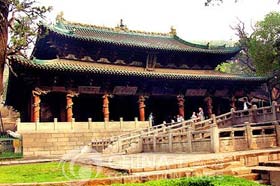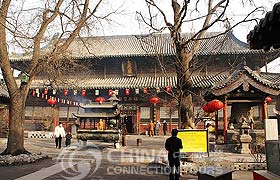 Throughout history, Taiyuan has been called the "town of beautiful landscapes" for its abundant natural attractions and cultural relics.
Throughout history, Taiyuan has been called the "town of beautiful landscapes" for its abundant natural attractions and cultural relics.
Situated 25 km to the southwest of Taiyuan, Jinci Temple is a dazzling pearl exemplifying Chinese culture. Inside the temple stand magnificent halls and gardens full of relics, such as Saintly Mother's Hall, Fish Pond with Plying Beam, Golden Figure Platform, colored sculptures of maidens of the Song dynasty, tablets with calligraphy by a Tang emperor, a cypress planted in the Zhou dynasty, a pagoda tree planted in the Tang dynasty, Longevity Spring, Tangshu Temple, Xiandian Hall and Chaoyang Cave. Besides the temple are Jinxi College and Wang Temple.
In the east of Taiyuan, the Twin Pagoda (or Yongzuo) Temple, built in the Ming dynasty, is the symbol for Taiyuan.
Thirty-six kilometers to the southwest of Taiyuan, Tian Longshan Grotto - with 25 existing caves from the Bei Chao period carved in the Tianlong style - was begun during the Five States dynasty and finished in the Yuan dynasty. Over 500 of the Buddhist sculptures were used as models for others around China. Highly valued by art historians, the 1144 frescos have simultaneously vivid and delicate beauty.
Situated 20 km in the southwest, the Longshan Grotto was built in the Tang dynasty and finished in the Yuan dynasty. In the existing eight caves, the carved figures of the saints and seven pupils of the Taoist ancestor Wang Chongyang make this grotto one of the most important Taoist sites in China.
 Chongshan Temple, built in the Tang dynasty, has the largest collection of Chinese Buddhist scriptures, totaling 20 thousand volumes. Ming dynasty frescoes also adorn the temple walls. Furthermore, Dabei Hall highlights the temple's wooden architecture from the Ming dynasty. The arrangement of galleries and pavilions represent the architecture and horticulture of the period. Also displayed at the temple is a bronze sculpture of marshal Guan Yu's horse. The Shanxi Museum, located at the temple, exhibits pottery, porcelain, bronze wares, coins, sculptures, lacquer wares, enamel wares, calligraphy and paintings from the province's history.
Chongshan Temple, built in the Tang dynasty, has the largest collection of Chinese Buddhist scriptures, totaling 20 thousand volumes. Ming dynasty frescoes also adorn the temple walls. Furthermore, Dabei Hall highlights the temple's wooden architecture from the Ming dynasty. The arrangement of galleries and pavilions represent the architecture and horticulture of the period. Also displayed at the temple is a bronze sculpture of marshal Guan Yu's horse. The Shanxi Museum, located at the temple, exhibits pottery, porcelain, bronze wares, coins, sculptures, lacquer wares, enamel wares, calligraphy and paintings from the province's history.
Ruins of the ancient Jinyang city lay southwest of the modern city of Taiyuan. You can find remnants of a wall, a palace terrace and surrounding villages that tell of the faded glory of ancient Jinyang.
The Provincial Government Buildings, located on Fuxi Street, house the People's Government of Shanxi and in the ancient times was the site of the Tang Ming town and site of Jin Wengong Temple for the emperor of the Jin State. When the Song dynasty besieged Jinyang, Marshal Pan Mei set up his headquarters in the temple. After the rebuilding of Jinyang, the city was controlled by the Song dynasty. Despite the passing of dynasties and time, this site has remained the center of power and is now the seat of the provincial government.

